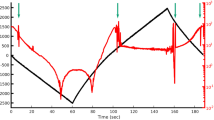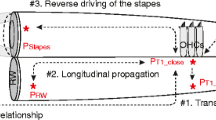Abstract
Tympanometry is a relatively simple non-invasive test of the status of the middle ear. An important step towards understanding the mechanics of the middle ear during tympanometry is to make vibration measurements on the eardrum under tympanometric pressures. In this study, we measured in vivo vibration responses in 11 gerbils while varying the middle-ear pressure quasi-statically, with the ear canal at ambient pressure. Vibrations were recorded using a single-point laser Doppler vibrometer with five glass-coated reflective beads (diameter ~ 40 μm) as targets. The locations were the umbo, mid-manubrium, posterior pars tensa, anterior pars tensa and pars flaccida. As described in earlier studies, the unpressurized vibration magnitude was flat at low frequencies, increased until a resonance frequency at around 1.8–2.5 kHz, and became complex at higher frequencies. At both the umbo and mid-manubrium points, when the static pressure was decreased to the most negative middle-ear pressure (− 2500 Pa), the low-frequency vibration magnitude (measured at 1.0 kHz) showed a monotonic decrease, except for an unexpected dip at around − 500 to − 1000 Pa. This dip was not present for the pars-tensa and pars-flaccida points. The resonance frequency shifted to higher frequencies, to around 7–8 kHz at − 2500 Pa. For positive middle-ear pressures, the low-frequency vibration magnitude decreased monotonically, with no dip, and the resonance frequency shifted to around 5–6 kHz at + 2500 Pa. There was more inter-specimen variability on the positive-pressure side than on the negative-pressure side. The low-frequency vibration magnitudes on the negative-pressure side were higher for the pars-tensa points than for the umbo and mid-manubrium points, while the magnitudes were similar at all four locations on the positive-pressure side. Most gerbils showed repeatability within less than 10 dB for consecutive cycles. The results of this study provide insight into the mechanics of the gerbil middle ear under tympanometric pressures.














Similar content being viewed by others
References
Akache F, Funnell WRJ, Daniel SJ (2007) An experimental study of tympanic membrane and manubrium vibrations in rats. Audiol Neurootol 12:49–58. https://doi.org/10.1159/000097247
de La Rochefoucauld O, Olson ES (2010) A sum of simple and complex motions on the eardrum and manubrium in gerbil. Hear Res 263:9–15Decraemer WF, Khanna SM (2000) Three-dimensional vibration of the ossicular chain in the cat. Fourth International Conference on Vibration Measurements by Laser Techniques: Advances and Applications, Ancona 401–411Decraemer WF, Khanna SM, Funnell WRJ (1997) Vibrations of the cat tympanic membrane measured with high spatial resolution. 20th Midwinter Res. Mtg., Assoc. Res. Otolaryngol., St. Petersburg Beach, FL.
Decraemer WF, Khanna SM, Funnell WRJ (1997) Vibrations of the cat tympanic membrane measured with high spatial resolution. St. Petersburg Beach, FL
Dirckx JJJ, Decraemer WF (2001) Effect of middle ear components on eardrum quasi-static deformation. Hear Res 157:124–137. https://doi.org/10.1016/S0378-5955(01)00290-8
Dirckx JJJ, Decraemer WF, von Unge M, Larsson C (1998) Volume displacement of the gerbil eardrum pars flaccida as a function of middle ear pressure. Hear Res 118:35–46. https://doi.org/10.1016/S0378-5955(98)00025-2
Ellaham NN, Akache F, Funnell WRJ, Daniel SJ (2007) Spatial vibration patterns of the gerbil eardrum. Can Acoust 35:38–39
Engel J (2008) Gerbils can tune in. J Physiol 586:919. https://doi.org/10.1113/jphysiol.2007.150409
Gea SLR, Decraemer WF, Funnell WRJ, Dirckx JJJ, Maier H (2010) Tympanic membrane boundary deformations derived from static displacements observed with computerized tomography in human and gerbil. J Assoc Res Otolaryngol 11:1–17. https://doi.org/10.1007/s10162-009-0192-9
Gyo K, Goode RL, Miller C (1986) Effect of middle ear modification on umbo vibration: human temporal bone experiments with a new vibration measuring system. Arch Otolaryngol Neck Surg 112:1262–1268
Kei J, Allison-Levick J, Dockray J, Harrys R, Kirkegard C, Wong J, Maurer M, Hegarty J, Young J, Tudehope D (2003) High-frequency (1000 Hz) tympanometry in normal neonates. J Am Acad Audiol 14:20–28. https://doi.org/10.3766/jaaa.14.1.4
de La Rochefoucauld O, Olson ES (2010) A sum of simple and complex motions on the eardrum and manubrium in gerbil. Hear Res 263:9–15
Lee C-Y, Rosowski JJ (2001) Effects of middle-ear static pressure on pars tensa and pars flaccida of gerbil ears. Hear Res 153:146–163. https://doi.org/10.1016/S0378-5955(00)00269-0
Maftoon N, Funnell WRJ, Daniel SJ, Decraemer WF (2013) Experimental study of vibrations of gerbil tympanic membrane with closed middle ear cavity. J Assoc Res Otolaryngol 14:467–481. https://doi.org/10.1007/s10162-013-0389-9
Maftoon N, Funnell WRJ, Daniel SJ, Decraemer WF (2014) Effect of opening middle-ear cavity on vibrations of gerbil tympanic membrane. J Assoc Res Otolaryngol 15:319–334. https://doi.org/10.1007/s10162-014-0442-3
Merchant SN, Ravicz ME, Puria S et al (1997) Analysis of middle ear mechanics and application to diseased and reconstructed ears. Otol Neurotol 18:139–154
Rosowski JJ, Davis PJ, Donahue KM, Merchant SN, Coltrera MD (1990) Cadaver middle ears as models for living ears: comparisons of middle ear input immittance. Ann Otol Rhinol Laryngol 99:403–412. https://doi.org/10.1177/000348949009900515
Rosowski JJ, Ravicz ME, Teoh SW, Flandermeyer D (1999) Measurements of middle-ear function in the Mongolian gerbil, a specialized mammalian ear. Audiol Neurotol 4:129–136
Shapiro R (2014) An experimental study of vibrations in the gerbil middle ear under static pressure. M.Eng. thesis, McGill University.
Teoh SW, Flandermeyer DT, Rosowski JJ (1997) Effects of pars flaccida on sound conduction in ears of Mongolian gerbil: acoustic and anatomical measurements. Hear Res 106:39–65. https://doi.org/10.1016/S0378-5955(97)00002-6
von Unge M, Bagger-Sjöbäck D, Borg E (1991) Mechanoacoustic properties of the tympanic membrane: a study on isolated Mongolian gerbil temporal bones. Am J Otol 12:407–419
von Unge M, Decraemer WF, Bagger-Sjöbäck D, Dirckx JJ (1993) Displacement of the gerbil tympanic membrane under static pressure variations measured with a real-time differential moire interferometer. Hear Res 70:229–242. https://doi.org/10.1016/0378-5955(93)90161-S
Voss SE, Rosowski JJ, Merchant SN, Peake WT (2001) Middle-ear function with tympanic-membrane perforations. I Measurements and mechanisms. J Acoust Soc Am 110:1432–1444
Acknowledgements
The authors would like to thank Dr. Aurore Dodelet-Devillers for her help with the handling of the animals, anaesthesia and surgical procedures; Dr. Ross Wagner for his help in the development of the acoustic coupler and the experimental setup; Mr. Sajjad Feizollah and Dr. Majid Soleimani for their help with the surgical procedure; and the McGill University Health Centre Research Institute Vivarium staff for their help in maintaining and advising on the health and comfort of the animals.
Funding
This work was supported in part by the Canadian Institutes of Health Research, the Natural Sciences and Engineering Research Council (Canada), the Fonds de recherche en santé du Québec, the Montréal Children’s Hospital Research Institute and the McGill University Health Centre Research Institute.
Author information
Authors and Affiliations
Corresponding author
Ethics declarations
Conflict of Interest
The authors declare that they have no conflict of interest.
Ethics Statement
This study received ethics approval from the Institutional Review Board of the McGill University Health Centre Research Institute.
Additional information
Publisher’s Note
Springer Nature remains neutral with regard to jurisdictional claims in published maps and institutional affiliations.
Rights and permissions
About this article
Cite this article
Kose, O., Funnell, W.R.J. & Daniel, S.J. Vibration Measurements of the Gerbil Eardrum Under Quasi-static Pressure Steps . JARO 21, 287–302 (2020). https://doi.org/10.1007/s10162-020-00763-2
Received:
Accepted:
Published:
Issue Date:
DOI: https://doi.org/10.1007/s10162-020-00763-2




